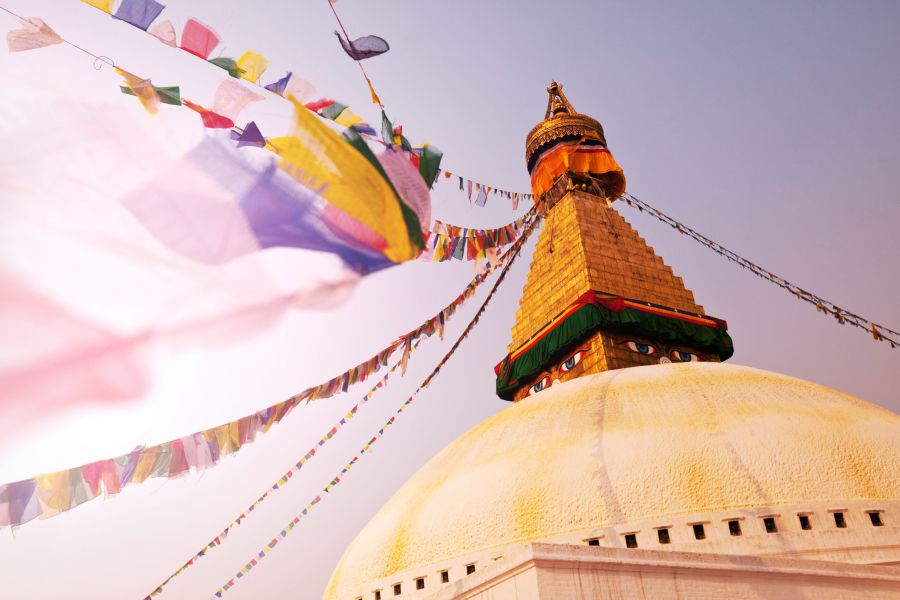Authentic Nepal Explorer: Sherpa Village Trek
One of the world's most popular and sought-after trekking experiences. After your short flight to the far-flung village of Lukla from Kathmandu, embark on a nine-day adventure through villages and rivers, and over bridges and mountain ridges. The Khumbu region is dotted with villages somehow glued onto the sides of mountain peaks. From these villages, views of the Himalayas are unbeatable. Use the town of Namche as your base while in the region, being guided by your personal sherpa, who will educate you completely on the life and cultures of the Himalayan peoples.
Daily Itinerary
Day 1: Kathmandu Arrival
- Transportation: Airport Transfer
- Accommodation: Hotel Shambala Kathmandu
Today, you will be picked up at the airport and transferred to your hotel. Check in and enjoy the remainder of the day free after your long flight.
Day 2: Kathmandu
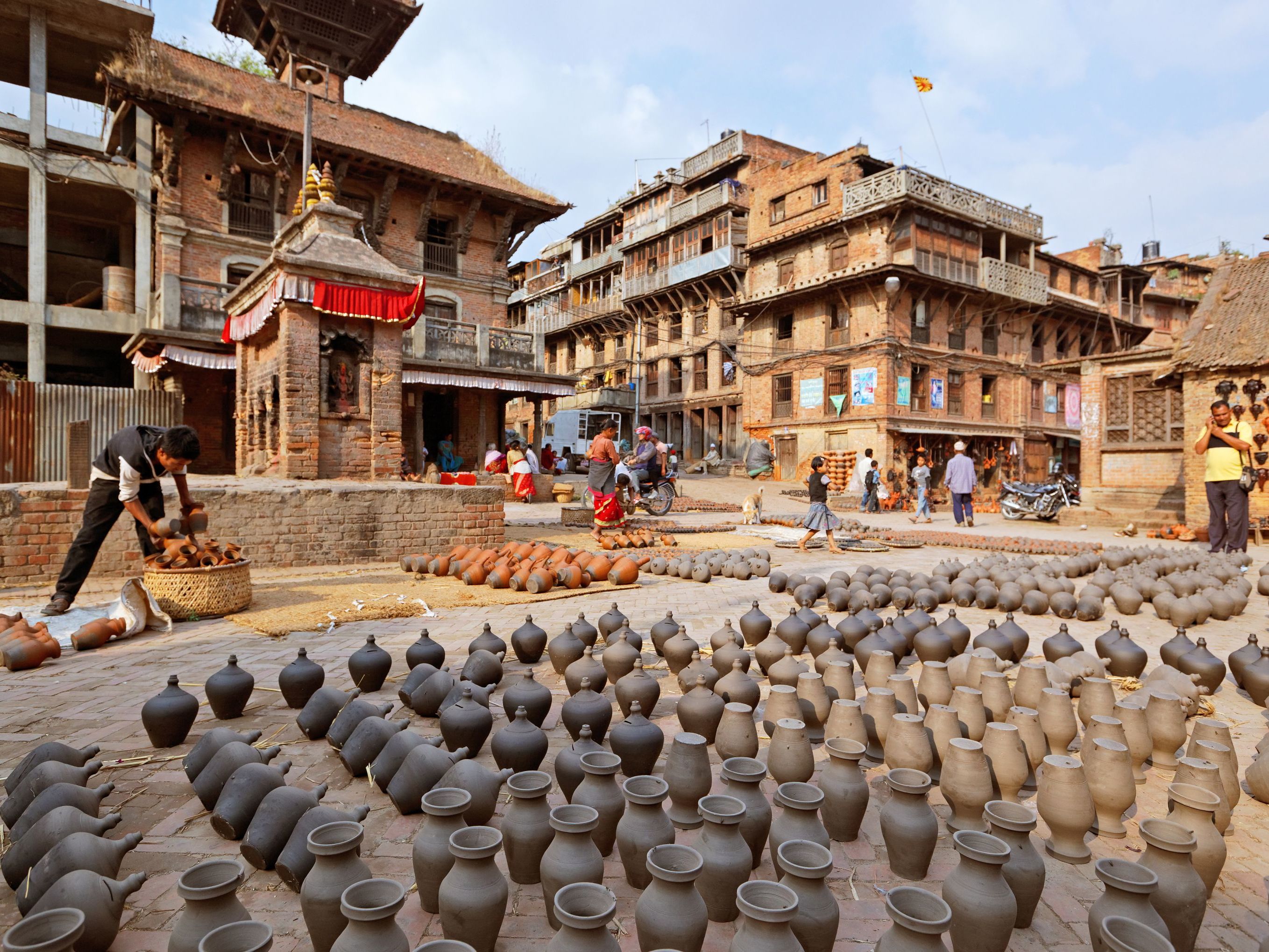
- Tour: Pashupatinath, Boudhanath & Bhaktapur
- Accommodation: Hotel Shambala Kathmandu
- Meals: B
Pashupatinath, Boudhanath & Bhaktapur
Today you will be met by your guide for a full day sightseeing tour including visits to Pashupatinath, Boudhanath, and Bhaktapur.
Pashupatinath, the most sacred of all Hindu temples in Nepal situated on the banks of the holy Bagmati River. Non Hindus are not allowed to enter the temple precincts but may look into premises from the opposite bank. It draws tens of thousands of pilgrims and devotees from Nepal and India during the festival of Mahashivaratri (the night of Lord Shiva).
Boudhanath, possibly the world's largest Buddhist stupa and a site of great veneration for Buddhists, around the stupa have sprung up number of monasteries of the different sects of Tibetan Buddhism including one (on the west side of the stupa) that houses an enormous seated statue of Maitreya Buddha splendidly adorned.
Bhaktapur, home of medieval art and architecture, also known as the 'City of Devotees'. Tread the 17th century along cobbled pavements and marvel at the ancient architectures. Visit the Lion Gate, the Picture Gallery, the Golden Gate, and the Palace of Fifty five Windows.
Day 3: Kathmandu - Sherpa Village Trek
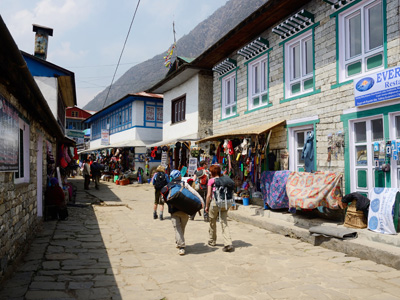
- Tour: Kathmandu - Lukla - Chumoa
- Accommodation: Local Tea House
- Meals: B, D
Kathmandu - Lukla - Chumoa
Our early morning flight by Twin Otter aircraft or MI-17 helicopter rushes us to Lukla (2880m), the most renowned mountain airstrip in the world. Originally conceived by Sir Edmund Hillary’s Himalayan Trust as an emergency evacuation runway for casualties brought to the Trust’s hospital at nearby Kunde, Lukla is now one of the busiest runways in Nepal. On the flight we watch the rugged foothills give way to the snowline of the Himalaya; many of the world’s highest mountains, including Kanchenjunga, Lhotse and Makalu (the world’s 3rd, 4th, and 5th highest respectively) may sometimes be seen from the window of the plane.
On arrival, we meet our Sherpas and after a cup of tea we pick up the trail out of Lukla. Surprisingly, this high altitude trek begins by descending to the river at Phakding. Further on and we choose one of several good camp sites in a wooded area at Chumoa (2743m), close to the entrance to the Sagarmartha National Park.
Trek time: 5-6 hours
Day 4: Sherpa Village Trek
- Tour: Chumoa - Namche
- Accommodation: Local Tea House
- Meals: B, L, D
Chumoa - Namche
The first day may have been surprisingly long for some, but camping at Chumoa allows us to begin the ascent to Namche Bazaar first thing in the morning. At about half-way up the hill, a gap in the trees allow us to spy Everest for the first time. If the weather is clear the top of the South-West Face will be just visible behind the long Lhotse-Nuptse ridge. A plume can often be seen stretching away from the very summit.
Trek time: 6-7 hours
Namche is the most prosperous and the largest town in the Khumbu. A bazaar is held here every Saturday. The wares on display include meat, grains and vegetables, tennis shoes and trinkets as well as hand woven aprons and Tibetan boots. The Sherpas play host to trader from the foothills, as well as Tibetans from over the border. Thamserku (6648m), Kwangde Ri (6187m) and Khumbila (5707m) surround the natural bowl that Namche sits in.
Day 5: Sherpa Village Trek
- Tour: Namche Rest Day
- Accommodation: Local Tea House
- Meals: B, L, D
Namche Rest Day
We take the day off to allow our bodies to adjust to the rarefied atmosphere before ascending to higher altitudes. The secret of safe acclimatization is to ‘climb high, sleep low’ so it is safe for the more energetic amongst us to hike up the hill behind Namche to the airstrip at Syangboche, or stroll across to the museum behind the police post. Others may prefer to ‘chill out’ and visit one of the lodges for a freshly-baked cinnamon roll. Namche is a busy and bustling trading place and there is always plenty going on.
Day 6: Sherpa Village Trek
- Tour: Namche - Thame
- Accommodation: Local Tea House
- Meals: B, L, D
Namche - Thame
After our day off we traverse west, enjoying marvelous view of Kwangde Ri and the waterfalls that cascade off its flanks. The trail stay high up on the bank of the Bhote Khose, and we wander through a yellow and white rhododendron forest that comes into full bloom in May. As we cross the river, we look back down the valley for beautiful views of Thamserku and Kusum Kangru (6369m), before ascending through more rhododendron forest to pasture lands in front of Thame. This is the birth place of Tenzing Norgay, the Sherpa who made the first ascent of Everest with Hillary in 1953. We camp in meadows at the edge of the village. The hour-long climb to the cliff side monastery is well worth the effort. From this point, trekkers can skirt above the village to climb across the ridge in order to view the route to the Nangpa La, a pass to Tibet frequently used by the Sherpas and their yaks during the monsoon.
Trek time: 6-7 hours
Day 7: Sherpa Village Trek
- Tour: Thame - Khumjung
- Accommodation: Local Tea House
- Meals: B, L, D
Thame - Khumjung
We return back down the valley via Thamo, a hillside nunnery, and then take a high trail that by-passes Namche and finally drops into Khumjung. This village is one of the most beautiful in Khumbu. The Himalayan Trust has a school here, as well as a medical post (for locals and trekkers) in nearby Khunde.
Trek time: 5 hours
Day 8: Sherpa Village Trek
- Tour: Khumjung - Tengboche
- Accommodation: Local Tea House
- Meals: B, L, D
Khumjung - Tengboche
The trail this morning descends to the Dudh Khosi. There are spectacular views of Ama Dablam (6696m) and Kantega (6779m) as well as Everest (8848m) and Lhotse (8501m). Keep a look-out too for pheasant in the undergrowth. We cross the river at Phunki Thanga and climb through the afternoon amongst rhododendron forest to the saddle at the top of the hill. Suddenly in front of us is Tengboche, the principal monastery of the Khumbu area; the views from here are unforgettable.
Trek time: 5-6 hours
Day 9: Sherpa Village Trek
- Tour: Tengboche -Namche
- Accommodation: Local Tea House
- Meals: B, L, D
Tengboche -Namche
From the monastery we trek down, down, down to Phunki (3250m) and the bridge across the Imja Khola. An enjoyable climb then leads up the side of the valley and around to Namche Bazaar, the most well-known and written-about valley in the Khumbu. After the last two weeks, Namche appears to offer many of life’s luxuries.
Trek time: 6 hours
Day 10: Sherpa Village Trek
- Tour: Namche - Lukla
- Accommodation: Local Tea House
- Meals: B, L, D
Namche - Lukla
Most people head towards Lukla with a heavy heart. There is something very special about the setting, the villages and the people of the high Khumbu hills and valleys and it the deceptively long hard climb leading up to Lukla. Our campsite and house are well located and offer a good final resting spot for (hopefully) the one night stay before the early morning departure.
Trek time: 7-8 hours
Day 11: Sherpa Village Trek - Kathmandu
- Tour: Lukla - Kathmandu
- Accommodation: Hotel Shambala Kathmandu
- Meals: B
Lukla - Kathmandu
Another chance to enjoy this great flight. Please note that flights into Lukla are sometimes delayed due to weather conditions either in fog-bound Kathmandu or windy Lukla; be reassured that our staff in Lukla and in Kathmandu will be doing everything possible to minimize the inconvenience caused if this happens. Your patience in the trying circumstances which can occur will be greatly appreciated.
On arrival back in Kathmandu, you will be transferred to your hotel.
Day 12: Kathmandu

- Tour: City Tour, Swayambhunath & Patan
- Accommodation: Hotel Shambala Kathmandu
- Meals: B
City Tour, Swayambhunath & Patan
Today you will enjoy a guided sightseeing tour of Kathmandu City, Swayambhunath, Patan City and the Patan Museum.
Although the fertile Kathmandu Valley has been inhabited for thousands of years, its rich and varied cultural legacy essentially began during the 14th century under the Malla Dynasty. Patronized by the nobility, Newar artisans constructed temples, monasteries and elaborate courtyards that constitute a fascinating architectural history. Visit Durbar Square and Teleju Temple with its gilded roofs; the present temple was restored by King Mahendra Malla in 1562. The gate to the Hanuman Dhoka Durbar, the old Royal Palace, is guarded by a statue of Hanuman, the monkey - god, wrapped in a red cloak’ the deity’s face is covered by a thick layer of sindur, a red dust mixed with mustard oil. Stop at House of the Living Goddess where the virgin goddess known as Kumari may look sown from one of the upper floor windows. Kathmandu derives its name from the 12th century wood temple of Kasthamandap, said to have been built from a single tree. Walk through the bazaar and labyrinthine back streets of the old city.
Move on to Swayambhunath - the “Monkey Temple”, the oldest shrine in the world established more that 2500 years ago. Situated on top of a high hill where legendary Manjushri discovered the lotus growing in the ancient Kathmandu Valley lake, Swayambhunath commands an superb view of the valley below. The four side of this ancient structure are painted with the compassionate eyes of Buddha. Between the eyes is a mystical third eye symbolizing true wisdom. The nose, appearing as an incomplete question mark, is the Nepalese number of one, a symbol of unity.
Patan City, the City of arts and architecture founded in 250 A.D. and also known as Lalitpur. It is renowned for its fine works in bronze, silver and copper. Visit the Durbar Square, Royal Baths, Mahaboudha, Krishna Mandir and Hiranya Verna Mahabihar (the Golden Temple). A visit to the new Patan Museum is a must. The museum faces Durbar Square and is housed in a beautifully restored and renovated former Malla residential palace. The collection spans much of Nepal’s cultural history, primarily exhibiting metalwork sculptures from Hindu and Buddhist deities, typical of Patan’s tradition in craftsmanship. Written commentary explains their significance to Nepal’s art history, spiritualism, cultural heritage and contemporary life.
Day 13: Kathmandu
- Accommodation: Hotel Shambala Kathmandu
- Meals: B
Enjoy this last full day of your trip at leisure in Kathmandu.
Day 14: Kathmandu Departure
- Transportation: Airport Transfer
- Meals: B
Today, you will be picked up at your hotel and transferred to the airport for your departing flight. We hope you enjoyed your time in Nepal and we wish you a pleasant flight home.
Accommodation
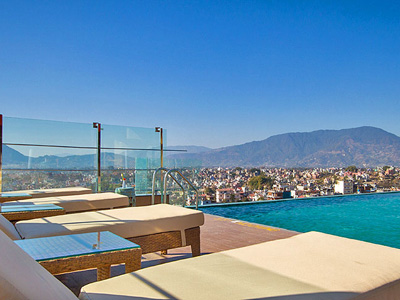
Hotel Shambala Kathmandu
Hotel Shambala, a contemporary Tibetan themed boutique hotel in Kathmandu, Nepal offers unparalleled comfort and luxury with the best in Tibetan and Nepalese hospitality. Inspired by Tibetan art and architecture, all 65 rooms feature beautiful handmade furniture, rugs and painted motifs; creating an ambiance that is traditional yet modern. Rest in our beautiful rooms equipped with en-suite bathrooms, air-conditioners, Wi-Fi, LED TV and a range of other amenities. Enjoy fine Asian and Continental cuisines prepared by our experienced chefs or espresso beverages with fresh-baked bread and pastries. Relax with a swim or soak in the sun poolside and enjoy the beautiful views, or experience a rejuvenating session at Ayatana Spa.
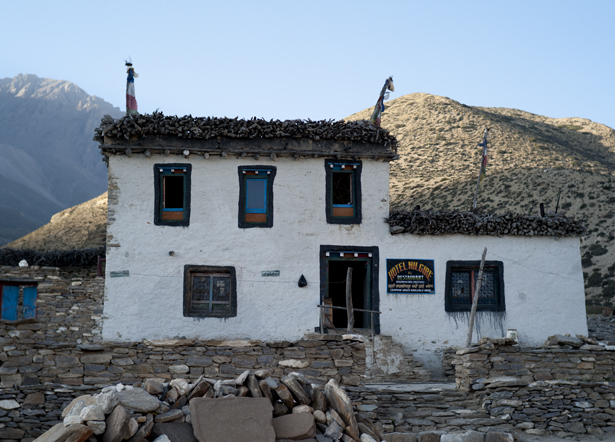
Local Tea House
A tea house is a combination restaurant, hotel and local meeting spot. The rooms and facilities are usually simple, but clean, safe and comfortable. A trek between local tea houses, offers the flexibility to arrange daily accommodations and meals at your own pace. The meals are plentiful and delicious. Breakfast typically includes a mix of toast, eggs, pancakes and local options. Lunch and dinner usually feature potatoes, curries, rice, noodles, pasta, pizza, spring rolls and traditional Nepali dishes. Since the tea house acts as a local meeting spot for the village as well, you can enjoy the unique experience of getting to know the local people, who come in for a meal or drink! If you are not staying in a tea house, you will be camping with the full support of your Sherpa staff.
Pricing and Details
Starting from $ 5,523 per person
*Pricing is based on two persons traveling together, based on availability, subject to change.
Price Includes
- Full support before, during & after your trip
- Meals as mentioned
- Accommodation as mentioned
- Tours/activities as mentioned
- Transport as mentioned
Price Excludes
- International & domestic flights
- Travel insurance (highly recommended)
- Entrance visas when applicable
- Other services not mentioned
- Tips and gratuities to guides, drivers
- Taxes and fees
Why Global Basecamps
Request Free Quote
Our entire team is dedicated to making this custom journey come true. Request a free quote by filling out the form and please share any details to help us customize this perfect trip just for you.
Can’t wait another minute? We understand, call us directly at (866) 577-2462 and speak with one of our extraordinary travel specialists.

